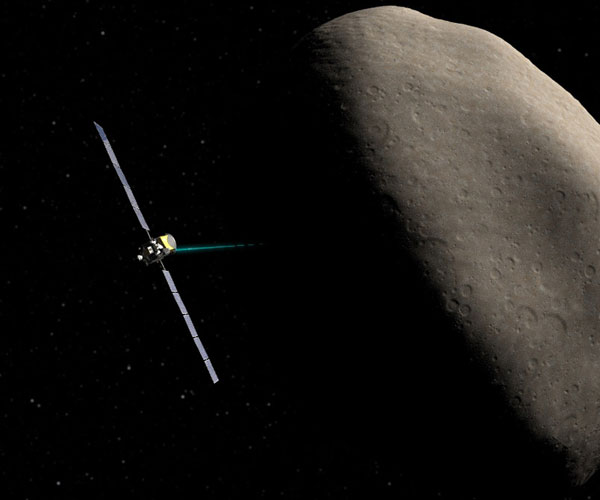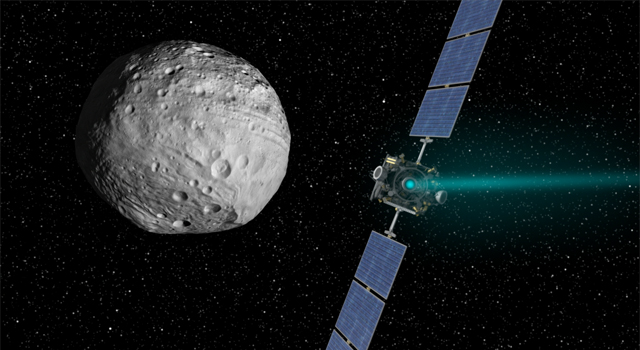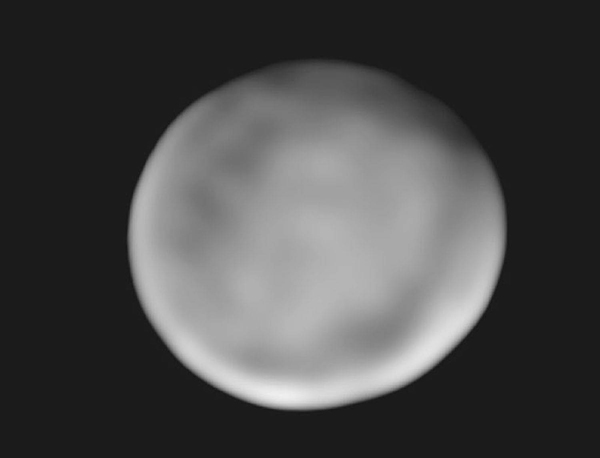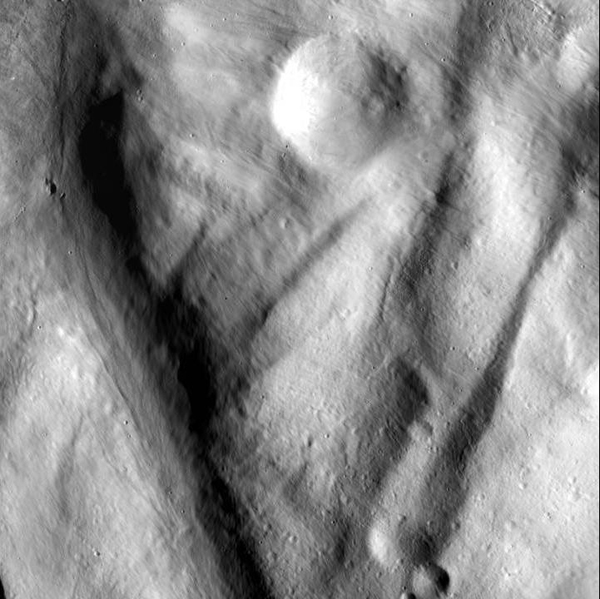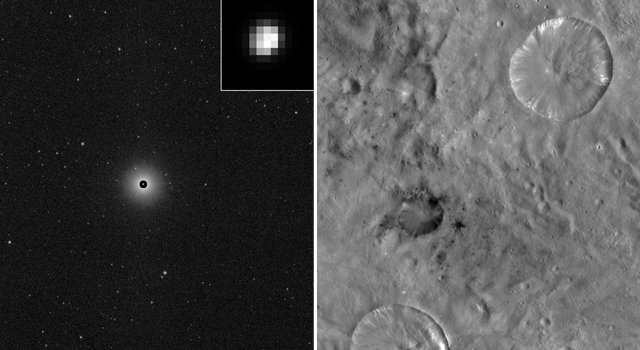The Giant Asteroid: A Retrospective
Thursday, January 31st, 2013
As NASA’s Dawn spacecraft makes its journey to its second target, the dwarf planet Ceres, Marc Rayman, Dawn’s chief engineer, shares a monthly update on the mission’s progress.
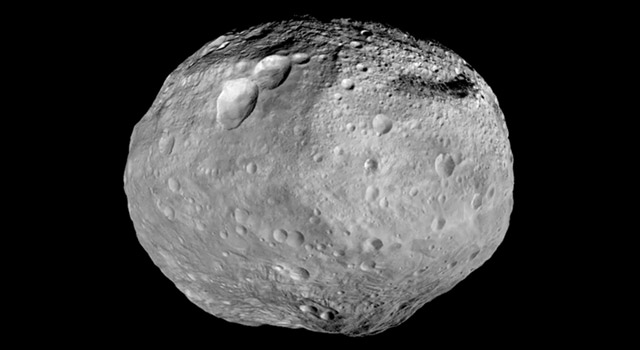
As NASA’s Dawn spacecraft takes off for its next destination, this mosaic synthesizes some of the best views the spacecraft had of the giant asteroid Vesta. Image credit: NASA/JPL-Caltech/UCAL/MPS/DLR/IDA
› full image and caption
Dear Dawnt Look Backs,
Its long and daring interplanetary journey continuing smoothly, Dawn is making good progress in gradually reshaping its orbit around the sun. Its uniquely efficient ion propulsion system is gently bringing it closer to its next destination, dwarf planet Ceres, and ever farther from its previous one, Vesta. Although the robotic explorer’s sights are set firmly ahead, let’s take one last look back at the fascinating alien world it unveiled during its 14 months in orbit there.
Vesta, the second most massive resident of the main asteroid belt between Mars and Jupiter, was discovered in 1807. For more than two centuries thereafter, the mysterious object appeared as little more than a fuzzy patch of light among the stars. The only one of the millions of main belt asteroids to be bright enough to be visible to the naked eye, Vesta beckoned, but its invitation was not answered until Dawn arrived in July 2011, nearly four years after it left distant Earth. The cosmic ambassador is the only spacecraft ever to have orbited an object in the main asteroid belt, and its ambitious mission would have been impossible without ion propulsion.
Dawn found a complex and exotic place, and it returned a fabulously rich collection of pictures and other measurements that will continue to be analyzed for many, many years. For now, we will simply touch on a very few of the many insights that already have been illuminated by the light of Dawn.
Scientists recognize Vesta as being more like a mini-planet than like the chips of rock most people think of as asteroids. The behemoth is 565 kilometers (351 miles) wide at the equator and has a surface area more than twice that of California (although it is populated by far fewer eccentrics, billionaires, and other colorful characters found in that state). Dawn’s measurements of the gravity field provide good evidence that Vesta separated into layers, much like Earth did as the planet was forming. Vesta’s dense core, composed principally of iron and nickel, may be 200 to 250 kilometers (125 to 150 miles) across. Surrounding that is the mantle, which in turn is covered by the veneer of the crust, about 20 kilometers (12 miles) thick. The once-molten core is now solid (in contrast to Earth’s, which remains hot enough to be liquid), but the differentiation into layers gives Vesta a key distinction from most asteroids. Because it was likely still in the process of accumulating material to become a full-sized planet when Jupiter’s immense gravity terminated its growth, scientists often refer to Vesta as a protoplanet.
Among the most prominent features of the alien landscape is a huge gouge out of the southern hemisphere so large that its presence was inferred from observations with the Hubble Space Telescope. Dawn found this gigantic crater to be even deeper and wider than expected, penetrating about 19 kilometers (12 miles) and spanning more than 500 kilometers (310 miles), or nearly 90 percent of the protoplanet’s equatorial diameter.
The yawning hole is now known as Rheasilvia, after the Vestal Virgin who not only was the mythical mother of Romulus and Remus, but also surely would have been astounded by the spectacular sights on Vesta as well as the spacecraft’s capability to point any user-defined body vector in a time-varying inertial direction defined by Chebyshev polynomials. As Dawn has brought Vesta into focus, cartographers have needed labels for the myriad features it has discovered. The International Astronomical Union names Vestan craters for Vestal Virgins and other famous Roman women; mountains, canyons, and other structures are named for towns and festivals associated with the Vestal Virgins.
Vesta dates to the dawn of the solar system, more than 4.5 billion years ago, and its age shows. Myriad craters tell the story of a timeworn surface that has been subjected to the rough and tumble conditions of life in the asteroid belt ever since. A virtual rain of space rocks has fallen upon it. While Rheasilvia records the most powerful punch, from an object as much as 50 kilometers (30 miles) across, there are at least seven craters, some quite ancient indeed, more than 150 kilometers (nearly 100 miles) in diameter. As the eons pass, craters degrade and become more difficult to discern, their crisp shapes eroded by subsequent impacts large and small.
The long history of cratering is particularly evident in the startling difference between the northern and southern hemispheres. The north is very densely cratered, but the south is not. Why? The titanic blow that carved out Rheasilvia is estimated to have occurred over one billion years ago. It excavated a tremendous volume of material. Much of it fell back to the surface, wiping it clean, so the cratering record had to start all over again. Recall that the crater itself is 500 kilometers (310 miles) in diameter, and scientists estimate that 50 kilometers (30 miles) outside the rim, the debris may have piled about 5 kilometers (3 miles) high. Even at greater distances, preexisting features would have been partially or completely erased by the thick accumulation. The effect did not reach to the northern hemisphere, however, so it retained the craters than had formed before this enormous impact.
Some of the rocks were ejected with so much energy that they broke free of Vesta’s gravitational grip, going into orbit around the sun. They then went their own way as they were yanked around by the gravitational forces of Jupiter and other bodies, and many of them eventually made it to the part of the solar system where your correspondent and some of his readers spend most of their time: Earth. When our planet’s gravity takes hold of one of these Vesta escapees, it pulls the rock into its atmosphere. Some lucky witness might even observe it as a meteor. Its blazing flight to the ground is not the end of its glory, however, for these rocks are prized by planetary geologists and other enthusiasts who want a souvenir from that impact.
Scientists now know that about 6 percent of the meteorites that have been found originated on Vesta. Six percent! One of every 16 meteorites! This is an astonishingly large fraction. Apart from Mars and the moon, Vesta is the only known source of specific meteorites. Although rocks from Vesta had to travel much farther, they far outnumber meteorites from these other two more familiar celestial bodies.
Combining laboratory studies of the numerous samples of Vesta with Dawn’s measurements at the source provides an extraordinary opportunity to gain insights into the nature of that remote world. Meteorites from Vesta are so common that they are often displayed in museums (occasionally even without the curators’ awareness of their special history) and can be obtained from many vendors. Anyone who has seen or held one surely must be moved by contemplating its origin, so distant in space and time, from well beyond Mars and long before animal or plant life arose on Earth.
› Continue reading Marc Rayman’s Dawn Journal for more Vesta history




















